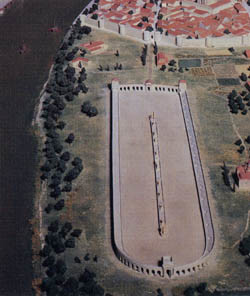
France > Provence-Alpes-Côte d'Azur > Bouches-du-Rhône > 13200 > Arles
Date: 149 Era: Antiquity Type: Public leisure architecture Status: Property of the Town of Arles, listed as a Historic Monument in 1992 and a UNESCO World Heritage Site in 1981.
The circus is the largest Roman monument and could only be located outside the town. It was built in the 2nd century to the south-west of the town, on the banks of the Rhône. It was mainly used for horse and chariot racing, but sometimes also for cavalry fighting and venationes, a kind of animal hunt. It must have been very difficult to construct. In view of the unstable nature of the land, it had to be built on thousands of timber piles. Its materials and decorations were dispersed at the end of the Empire and only a few pieces remain. Some were reused and some are exhibited at the Departmental Museum of Ancient Arles. However, its most sumptuous decoration is extremely famous; it is the obelisk installed in front of the hôtel de ville in the 17th century. The Arles circus was 450 metres long and 101 metres wide. It had rows of seats which could accommodate 20,000 spectators and a vast banked amphitheatre with a long central divide, the spina (spine), This spina, decorated with sculptures and basins, had a post (or meta) at either end, which the competitors tried to pass by as closely as possible. The track was surrounded by a wall (the podium), which was high enough to protect the spectators. The rows of seats were supported by a modular architectural structure of chambers covered by sloping vaults similar to that of an amphitheatre. Solid foundations were necessary, due to the instability of the clay soil. They consisted of 30,000 piles of wood 2 to 3.5 metres long. Today, all that can be seen below the museum are remains of the substructure of the cavea (slopes), the exterior of the spendone, the rounded part of the circus. The Roman circus in Arles was built in 149 AD, representing the largest urban extension of the time. This dating shows that the developments of the Flavian era continued until Emperor Antoninus Pius, at the apogée of the Empire. The building was drastically restructured in the 4th century. Excavations have shown that the spina was partially destroyed and then rebuilt with a new décor of marble plating and an obelisk. Small houses appeared around the circus and in the 5th century alveoles, although races were still taking place. The monument was destroyed in the mid-6th century, when its stone was needed to strengthen the town's walls. The rises in the levels of the Rhône soon covered the site in alluvium, and the remains of the circus were not uncovered until the 17th and 19th centuries, before in depth excavations in the 20th century.

A proximité:
Datatourism data updated on: 2023-12-12 05:15:26.873